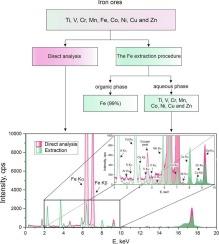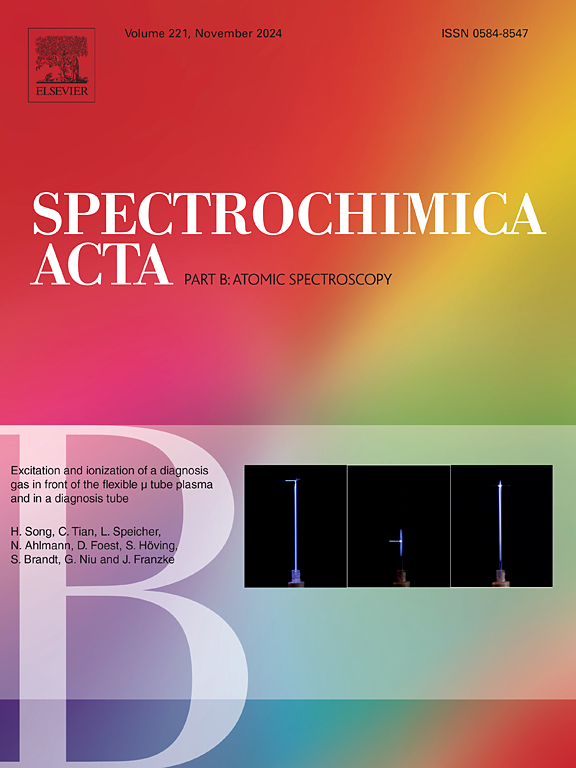液液萃取提高全反射x射线荧光法测定铁矿石中第四周期过渡金属灵敏度的适用性
IF 3.8
2区 化学
Q1 SPECTROSCOPY
引用次数: 0
摘要
地球化学样品光谱中铁的强烈x射线荧光和逸出峰的存在,对少量邻近元素的直接定量产生了负面影响。本文以铁矿分析为例,结果表明,与直接悬浮法相比,液液萃取法去除铁基体可提高第四周期过渡金属(Ti、V、Cr、Mn、Co、Ni、Cu、Zn)测定的灵敏度和准确性。采用王水对矿粉进行酸溶,用甲基异丁基酮从盐酸介质中去除铁,用TXRF测量含Ga为内标的水相。使用重复样品制备计算所有考虑元素的实验室内精度范围为1%至9%。铁萃取后,可以直接测定铁矿石样品中未检出的Co、V、Cr和Ni。然而,对于某些样品,由于含Cr的矿物在酸分解过程中没有完全溶解,因此只能认为是半定量测定。本文章由计算机程序翻译,如有差异,请以英文原文为准。

Applicability of liquid-liquid extraction to increase sensitivity of determination of fourth period transition metals in iron ores by total-reflection X-ray fluorescence analysis
The presence of intensive X-ray fluorescence of iron as well as escape peaks in the spectrum of geochemical samples has a negative impact on direct quantification of low amounts of neighboring elements. In this paper, using the analysis of iron ores as a case study, it is shown that removal of the iron matrix by liquid-liquid extraction improves the sensitivity and accuracy of determination of fourth-period transition metals (Ti, V, Cr, Mn, Co, Ni, Cu, Zn) compared to direct suspension analysis. A procedure involved acid digestion of ore powder by aqua regia, Fe removing with methyl isobutyl ketone from hydrochloric acid medium, TXRF measurement of aqueous phase containing Ga as an internal standard. Intralaboratory precision calculated using duplicate sample preparations ranged from 1 to 9 % for all considered elements. After extraction of iron, it became possible to determine Co, V, Cr and Ni which weren't detected in iron ore samples using direct analysis. However, for some samples, determination of Cr can be considered only as semi-quantitative because minerals containing Cr did not fully dissolve during acid decomposition.
求助全文
通过发布文献求助,成功后即可免费获取论文全文。
去求助
来源期刊
CiteScore
6.10
自引率
12.10%
发文量
173
审稿时长
81 days
期刊介绍:
Spectrochimica Acta Part B: Atomic Spectroscopy, is intended for the rapid publication of both original work and reviews in the following fields:
Atomic Emission (AES), Atomic Absorption (AAS) and Atomic Fluorescence (AFS) spectroscopy;
Mass Spectrometry (MS) for inorganic analysis covering Spark Source (SS-MS), Inductively Coupled Plasma (ICP-MS), Glow Discharge (GD-MS), and Secondary Ion Mass Spectrometry (SIMS).
Laser induced atomic spectroscopy for inorganic analysis, including non-linear optical laser spectroscopy, covering Laser Enhanced Ionization (LEI), Laser Induced Fluorescence (LIF), Resonance Ionization Spectroscopy (RIS) and Resonance Ionization Mass Spectrometry (RIMS); Laser Induced Breakdown Spectroscopy (LIBS); Cavity Ringdown Spectroscopy (CRDS), Laser Ablation Inductively Coupled Plasma Atomic Emission Spectroscopy (LA-ICP-AES) and Laser Ablation Inductively Coupled Plasma Mass Spectrometry (LA-ICP-MS).
X-ray spectrometry, X-ray Optics and Microanalysis, including X-ray fluorescence spectrometry (XRF) and related techniques, in particular Total-reflection X-ray Fluorescence Spectrometry (TXRF), and Synchrotron Radiation-excited Total reflection XRF (SR-TXRF).
Manuscripts dealing with (i) fundamentals, (ii) methodology development, (iii)instrumentation, and (iv) applications, can be submitted for publication.

 求助内容:
求助内容: 应助结果提醒方式:
应助结果提醒方式:


